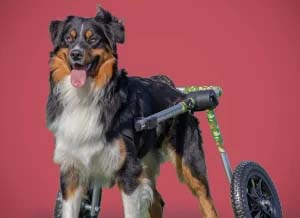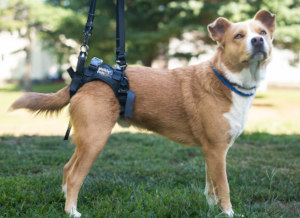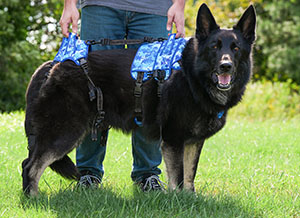- October 6, 2023
How Do You Deal With a Handicapped Dog?
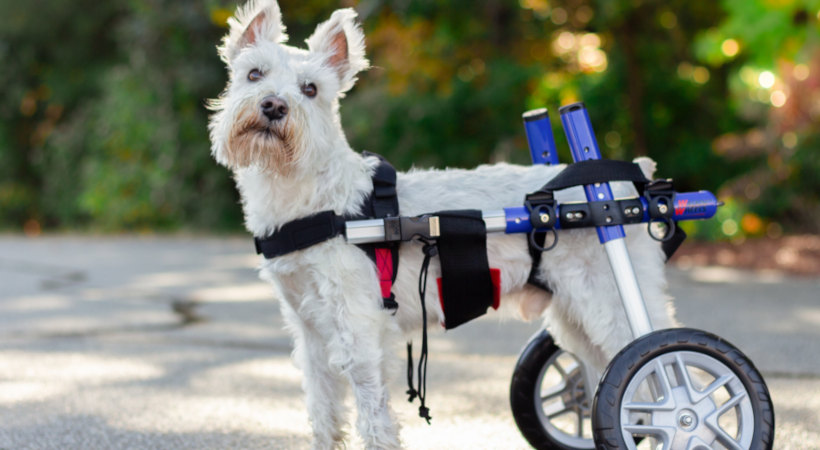
We all know the unwavering loyalty and boundless love of our furry best friend, but now picture them facing a life-altering challenge.
Whether it’s a sudden injury, illness, or a birth defect, watching your beloved dog navigate life as a handicapped pet can be both heart-wrenching and inspiring.
In this blog post, I want to share some of my experience on caring for a handicapped dog.
Read on because you will pick up practical tips on mobility aids to the emotional support they need and equip yourself with the knowledge and compassion to help your four-legged companion lead a happy and fulfilling life.
Caring for a Handicapped Dog
What does it actually mean when we talk about caring for a handicapped dog?
To me, it means providing them with a life filled with love, support, and opportunities to thrive.
In the following sections, we’ll break down the essential aspects of this journey.
Physical Care
First of all, you need to know that this job involves a commitment to their physical well-being that goes beyond the ordinary.
Your four-legged friend might have unique needs that require special attention and care.
Whether your dog is facing mobility challenges due to injury, illness, or a congenital condition, here’s how you can ensure their physical comfort and overall health.
- Specialized Nutrition: Just like any other dog, a handicapped dog needs a well-balanced diet. However, you might want to consult your veterinarian for dietary adjustments tailored to your dog’s specific condition.
- Hygiene and Grooming: Regular grooming and hygiene practices are essential to keep your dog comfortable and prevent skin issues. Pay close attention to areas where your dog might have limited mobility, such as under their belly or between their toes. Keeping their coat clean and free from tangles will also contribute to their overall comfort, and make sure to avoid all the common dog grooming injuries!
- Regular Veterinary Check-ups: Consistent veterinary care is vital to monitor your dog’s condition and address any emerging health issues promptly. Your vet can provide guidance on pain management, medication, and assistive devices, tailoring their recommendations to your dog’s unique needs. I recommend at least one visit a year.
- Assistive Devices: Depending on the nature of your dog’s disability, there are various assistive devices available that can enhance their quality of life. These can range from wheelchairs or harnesses for mobility support to orthopedic beds for comfort. I’ll share more on them in a later section.
- Pain Management: If your handicapped dog experiences pain or discomfort, talk to your vet about a pain management plan. In most cases, they can recommend medications, physical therapy, or other interventions to alleviate discomfort and improve your dog’s overall well-being.
Emotional Care
While physical care is crucial for your handicapped dog’s health, we mustn’t overlook the equally vital realm of emotional well-being. Just like their able-bodied counterparts, handicapped dogs have feelings, emotions, and a deep need for love and support. In this section, we’ll explore how you can provide the emotional care that will help your furry friend thrive.
- Unwavering Love and Support: Your handicapped dog relies on you for more than just physical assistance. They need your love, patience, and emotional support to navigate the challenges they face. Spend quality time with them, offer cuddles, and reassure them with soothing words. Your presence and affection can make a world of difference.
- Positive Reinforcement: Encourage and reward your dog’s efforts and achievements, no matter how small. Whether they’re learning a new way to move or overcoming a fear, positive reinforcement can boost their confidence and strengthen your bond.
- Mental Stimulation: While they might not be as mobile as before, their brains certainly haven’t changed. Engage your dog’s mind with interactive toys, puzzles, and games, which is as important if not more so for their overall well-being. It can help prevent boredom, depression, and anxiety, which are common among handicapped dogs.
- Socialization: Encourage interactions with other dogs, if possible, as well as with humans. Positive socialization experiences can boost your dog’s confidence and provide mental stimulation. However, ensure that these interactions are safe and comfortable for your dog.
- Training and Enrichment: Consider enrolling your handicapped dog in training classes specifically designed for dogs with special needs. These classes can help them learn new skills and build their self-esteem.
- Routine and Predictability: This is one the best things we can give our dogs in my opinion. Establishing a routine can provide a sense of security and predictability for your dog. Knowing what to expect in their daily life can reduce stress and anxiety.
Mobility and Exercise for Handicapped Dogs
It’s time to shift our focus to another crucial aspect of their well-being: Mobility and Exercise.
If we are able to help our dogs move comfortably and stay active, it boosts their physical health and also plays a significant role in getting their spirits up and improving the overall quality of life.
Here are some of my suggestions.
Mobility Aids
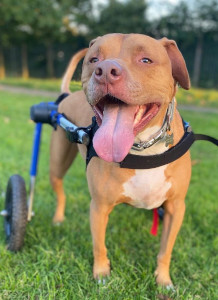
These innovative devices are designed to provide support and assistance tailored to your dog’s specific needs, allowing them to move with greater ease and independence.
- Wheelchairs: Dog wheelchairs are perhaps the most well-known mobility aids for handicapped dogs. They are customized to provide rear or full-body support, allowing your dog to walk, run, and play even when they have limited use of their limbs. Wheelchairs are super beneficial for dogs with hind leg weakness or paralysis.
- Harnesses and Slings: Supportive harnesses and slings are excellent tools for assisting your dog with walking and standing. They come in various styles and designs, including rear-support harnesses and full-body slings, to cater to your dog’s specific mobility requirements.
- Orthopedic Boots and Shoes: For dogs with paw or leg issues, orthopedic boots and shoes can provide added stability and protection. These footwear options can help your dog maintain traction on slippery surfaces and protect sensitive areas.
- Prosthetics: In some cases, dogs may benefit from custom-made prosthetic limbs. These prosthetics can replace a missing limb or provide additional support and stability to a weakened or injured limb.
- Mobility Suits and Vests: These specialized suits and vests offer support to dogs with conditions like hip dysplasia or arthritis. They provide compression and stability to improve your dog’s mobility and alleviate discomfort.
Exercise and Rehabilitation
These practices are not only crucial for maintaining physical strength but also for enhancing your dog’s overall well-being.
With the right approach, you can empower your furry friend to lead an active and fulfilling life.
- Consult Your Veterinarian: Before starting any exercise or rehabilitation program, check in with your vet first. They can assess your dog’s specific condition and might be able to create a tailored plan that takes into account their limitations and capabilities.
- Low-Impact Exercise: Low-impact activities, such as swimming or hydrotherapy, are excellent choices for handicapped dogs. These exercises provide cardiovascular benefits, strengthen muscles, and reduce stress on joints. Swimming, in particular, can be a great way for your dog to stay active without putting too much strain on their limbs.
- Physiotherapy and Massage: Canine physiotherapy and massage can alleviate muscle tension, improve circulation, and reduce pain. Regular sessions with a qualified therapist can greatly benefit your handicapped dog, promoting relaxation and aiding in the healing process.
- Gradual Progression: Don’t forget, your dog needs to start any exercise or rehabilitation program slowly and gradually increase the intensity. Always monitor your dog’s response and adjust the program as needed to prevent overexertion or discomfort.
- Positive Reinforcement: Use positive reinforcement techniques during exercise and rehabilitation sessions to keep your dog engaged and motivated. Reward them with treats, praise, and affection to make the experience enjoyable.
Living a Fulfilling Life with a Handicapped Dog
In this section, we’ll explore how to create a life filled with joy, socialization, interaction, and enjoyable activities for your furry friend.
By embracing these aspects, you’ll not only enhance your dog’s quality of life but also strengthen the bond you share, making every moment together truly special.
Socialization and Interaction
Just like any other dog, your handicapped pup craves meaningful connections and the chance to explore the world around them.
Let’s explore how you can nurture these essential aspects, enhancing their well-being and happiness.
- Playdates and Meet-Ups: Arrange playdates with other friendly dogs in your neighborhood or join dog-friendly meet-up groups. These interactions provide mental stimulation and a chance for your dog to engage in their favorite pastime – playing with fellow canines.
- Positive Encounters with People: Encourage your dog to engage with friends, family, and strangers who are willing to engage with your dog gently and positively. Building trust and forming bonds with humans is vital for their emotional well-being.
- Dog-Friendly Events: Seek out dog-friendly events or activities in your community, such as dog-friendly parks, pet-friendly cafes, or local dog-related events. These outings can be a fantastic way for your dog to experience new environments and meet new friends.
- Obedience and Trick Training: Engage your dog in obedience training or teach them fun tricks. Not only does this provide mental stimulation, but it also strengthens the bond between you and your furry friend. Positive training sessions can be both enjoyable and rewarding.
Fun Activities
Here, we’ll explore a variety of fun activities that you and your furry companion can embark on together, creating cherished memories that will last a lifetime.
- Nature Walks: Explore the great outdoors with your dog by taking leisurely nature walks. Choose accessible trails or paths that suit your dog’s mobility needs, allowing them to revel in the sights, sounds, and scents of the natural world.
- Sensory Adventures: Engage your dog’s senses with sensory adventures. Set up a small obstacle course in your backyard or living room, including items with different textures, scents, and sounds. Encourage your dog to explore and engage with each element.
- Pet-Friendly Beach Trips: If you live near the coast, consider taking your handicapped dog to the beach. The soft sand can be gentle on their paws, and the soothing sounds of the waves provide a relaxing backdrop for a day of seaside fun.
- Canine-Friendly Swimming: For dogs that enjoy the water, swimming can be a fantastic activity. Consider seeking out dog-friendly swimming pools or natural water bodies where your dog can paddle and play safely.
- Relaxation Time: Don’t underestimate the value of downtime with your dog. Simply cuddling up on the couch, watching a movie, or reading a book together can be a wonderful way to bond and enjoy each other’s company.
In Conclusion
Caring for a handicapped dog is a journey filled with compassion, resilience, and boundless love.
So, embrace the challenges and triumphs, and savor every moment with your handicapped dog!
Guest Author:
Zack Keithy
Zack Keithy is the Chief Editor at Daily Dog Drama. He was formerly a certified vet tech for a good 6 years before moving on to greener pastures. Right now, he is still heavily involved in dog parenting duties with his two dogs, Molly and Bella. At the same time, he is busy creating lots of useful resources like this dog pregnancy calculator for fellow dog owners to use. Check them out on his blog!
Related Articles:
Tags
What do you think?
Related Articles

New Puppy Checklist: Gear You’ll Need for Your New Dog
Getting a new puppy is really exciting, but before you welcome them home, it’s important to prepare your space for them. Since puppies need a

How Big Do Mini Poodles Get? Vet Reviewed Average Weight & Growth Chart – Dogster
The information is current and up-to-date in accordance with the latest veterinarian research. Learn more » When you buy a Miniature Poodle, you might not

Can Police Dogs Smell Nicotine? Vet Verified Facts & Info – Dogster
The information is current and up-to-date in accordance with the latest veterinarian research. Learn more » While cigarette sales have been declining steadily for decades,

How Old Is 5 in Dog Years? Vet-Approved Guide to Each Size of Dog – Dogster
The information is current and up-to-date in accordance with the latest veterinarian research. Learn more » A common method for calculating a dog’s age is


